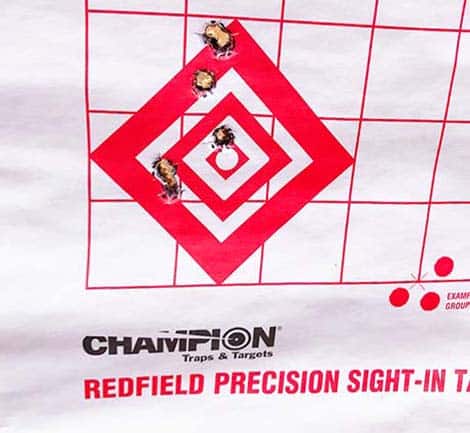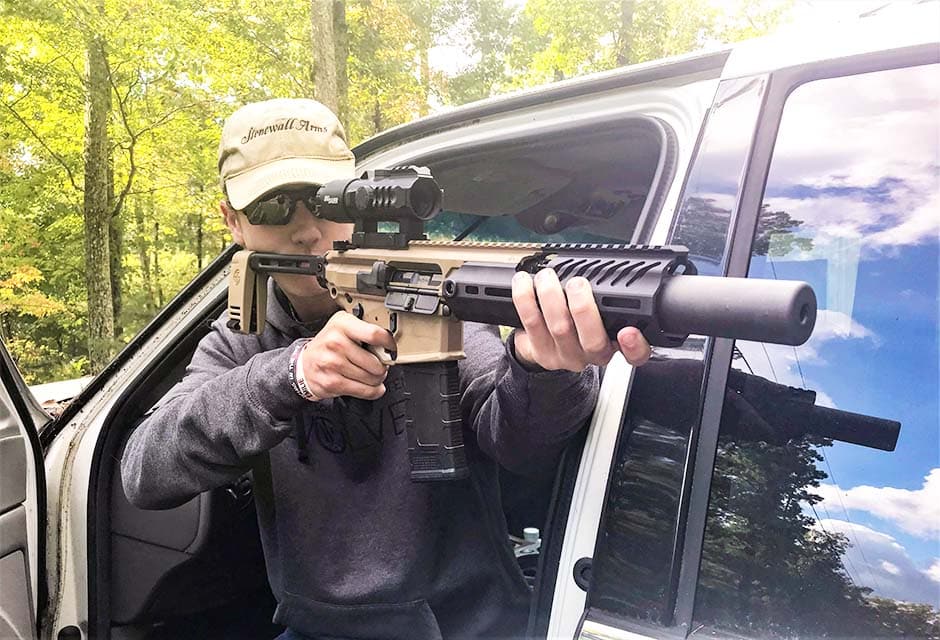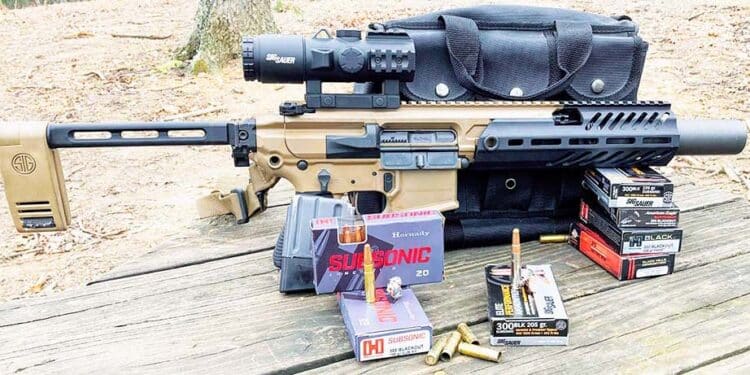
The 300 Blackout cartridge was created in response to a 2009 U.S. Special Operation Command’s request. SOCOM units were steadily involved in CQB operations in Iraq and Afghanistan where compact firearms were at a premium. Short-barreled 5.56mm M4 carbines were not cutting it. Advanced Armament Corporation (AAC) was given certain parameters to satisfy by the military procurement request — primary on this list was a .30 caliber cartridge that would be as quiet as a suppressed 9mm Heckler & Koch MP5-SD submachine gun while offering increased lethality, all out of an AR-style platform with a 9-inch barrel, using AR15 magazines. On top of this, the cartridge was to offer more power than the 7.62×39 from said short barrel. Both supersonic and subsonic factory ammunition that would work dependably with or without a suppressor was another key specification that sets the 300 AAC Blackout (300 Blk) apart from other AR compatible cartridge attempts. AAC was successful after making tweaks to the then existing 300 Whisper round creating the January 2011 SAAMI approved 300 Blk. From the onset, the M4/M16 platform was the primary vehicle to launch 300 Blk rounds. Designers kept this in mind during load development so as to ensure mechanical reliability while requiring minimal changes in the weapon to chamber the 300 Blk — basically just the barrel needed to be changed.
The 300 Blk’s raison d’être is as a CQB weapon typified by tight quarters and operational use indoors. Sounds like the ideal basis for a personal defense weapon. What distinguishes the 300 Blk is its ability to access standard, hard hitting supersonic rounds superior to 5.56mm while maintaining the trump card of subsonic ammunition if the end user desires. The 300 Blk cartridge has emerged as one of the most successful alternate AR chamberings. The ability to access either supersonic or subsonic factory ammunition offers great flexibility to the 300 Blk user; especially considering the special attention paid to its compatibility with the AR platform.
The 300 Blk chambering has grown beyond AR type weapons. Numerous manufacturers are offering bolt action and single shot rifles in 300 Blk. Anecdotal information compares 300 Blk 115-125 grain ammunition as offering superior ballistics over the 7.62x39mm AK and totally eclipses 5.56mm both in ballistics and terminal punch, as well. Our focus will be on subsonic use.

Tactically it is not hard to visualize what roles a suppressed 300 Blk stocked with subsonic rounds would fill. Anything from sentry removal, canine or two-legged, disabling lights and security cameras. CQB operations indoors also come to mind when communications between team members is a priority, especially during nighttime operations. If an enemy is not aware you are present, even when already being engaged you have a real tactical advantage. Subsonic rounds are downright spooky in their arrival when combined with use of a suppressor.
However, for most of us, we must see past operations equipped with night vision and zombie apocalypse scenarios in our thinking. Being able to maintain discretion is an important aspect to be considered in numerous situations. For example, how best to acquire food discretely and efficiently is too often pushed to the back of the bus in gun literature. A normal sounding rifle shot is sure to attract what could be unwanted attention. Personal defense where you must maintain situational awareness, i.e. hearing or being able to communicate with loved ones, also comes to mind. Here the terminal penetration of 300 Blk subsonic loads (similar to a 45 ACP pistol) compared to supersonic rifle loads through various mediums is not such a huge disadvantage.

Initial 300 Blk subsonic loads took advantage of the plethora of heavy .30 caliber bullets available for use; however, most were match-type bullets. The heavier .30 caliber bullets are comparatively long which created concerns for what twist rate best were best suited to stabilize the round, especially with short barrels that typify 300 Blk-chambered weapons. While 1:7-inch or faster (depending on barrel length) was found acceptable, terminal performance with the match rounds were lackluster resembling FMJ punch-through characteristics. How to get 300 Blk ammunition to expand AND penetrate with terminal effect became the next goal. Multiple manufacturers have responded to this challenge. We are going to focus on two of the larger ammunition producers to see what they came up with. Hornady and SIG SAUER each offer subsonic 300 Blk ammunition offering superior terminal performance while maximizing noise reduction when combined with suppressor.
Hornady’s Sub-X 300 Blk load consists of a 190-grain bullet designed specifically to perform at subsonic velocities. The Sub-X bullet combines a lead core surrounded by a grooved metal jacket and tipped with the company’s Flex Tip insert. A cannelure groove is present for a positive case crimp. Long grooves scored into the Sub-X metal jacket combined with flat base create conditions for reliable expansion. The Hornady-patented Flex Tip insert placed in front of hollow point cavity kicks expansion off when striking a target. The Flex Tip prevents material from clogging an exposed hollow point negatively effecting expansion. Hornady made sure the performance of the new load meets or exceeds the FBI’s terminal ballistic requirements. Additionally, a low flash signature makes the ammo ideal for both suppressed and unsuppressed firearms.
Let’s remember, subsonic 300 Blk loads resembles a pistol round’s ballistic performance. For comparison’s sake, a 230 grain 45 ACP generates 461 ft/lbs of energy. The Hornady 190-grain Sub-X makes 465 ft/lbs. All things being equal a high-SD bullet penetrates better than a low-SD bullet. (BC is a measurement of how well a bullet moves thru the air.) Superior ballistic coefficients (.437 for the 190 grain Sub-X versus .188 for a 45 ACP) and sectional densities (SD .286 versus .162) help the Hornady 190 grain Sub-X maintain energy and penetration characteristics further downrange than a typical pistol bullet. The SIG Sauer 205 grain Tipped Hunting benefits from these same qualities.
SIG’s relationship with our military forces is well known. Elite units often reach out directly to SIG for support. When subsonic bullet performance proved lacking SIG got the call. The SIG 205-grain Tipped Hunting ammunition was the result. Conversations with SIG, as well as an article from Tom Beckstrand provided insight into the SIG load. Remember our 300 Blk subsonic to handgun analogy? SIG turned to their proven V-Crown pistol bullet design as a starting point. A polymer tip was added to properly start expansion at sub-1000fps velocities. Something handguns often have to deal with.
One thing that immediately attracts your attention with the SIG round is the bullet profile. While .30 caliber as it emerges from the case mouth, the SIG 205 grain tipped bullet has shoulder that’s similar to a cartridge case that steps its diameter down. Why not keep the .30 caliber diameter farther out the ogive? The answer lies with 5.56mm AR magazines. A .30 caliber bullet ogive that extends too far out from a case neck causes issues with a typical 5.56mm AR magazine. Heavy grain 300 Blk loads can come into contact with a magazine’s interior supporting ribs that run along the inside of a magazine. Magazine side ribs can push the bullet noses towards the centerline of the magazine instead of keeping them parallel along the sides of the magazine, especially long heavy grain subsonic bullets. This can cause the rounds to sit at an angle once loaded making it problematic for the feed lips to provide reliable feeding. Thus, SIG designed a subsonic load with terminal ballistic qualities that also provides peace of mind when feeding from a 30-round magazine when cycling full-auto.

Range Time
After all this bullet background, it’s time to fire some. A SIG MCX Rattler Canebrake was chosen for range time. The MCX Canebrake is a military grade weapon in the hands of our elite operators along with British and other allies that civilians can easily obtain thanks to its pistol brace eliminating the need for an ATF tax stamp– sans full auto capability. Like the 300 Blk, the MCX series was driven by a tier one DOD unit request that sought to increase accuracy, modularity and durability over the legacy of the AR15/M16 system. Furthermore, the light weight, compact weapon was intended to be operated suppressed from its conception. A SIG SRD762 suppressor was placed under the MCX Rattler Canebrake’s oversized SD handguard.
What sets the SIG Canebrake apart, even from its larger Virtus brethren, is the compact size made possible via the 5.5-inch barrel with 1:5 twist. The 29.25-inch, 6.5-pound Rattler Canebrake is chambered in 300 Blk; an obvious decision considering the intent to suppress. A free-floating oversized M-LOK handguard is paired with a Canebrake-specific MCX compact upper matched with a side-folding, pivoting arm brace. SIG created the MCX Canebrake as the ideal choice for operators needing maximum firepower in a quiet discrete package.

With magazines loaded with Hornady 190-grain Sub-X and SIG 205-grain Tipped Hunting rounds, the suppressed SIG MCX Canebrake was taken to the Echo Valley Training Center’s (EVTC) for sighting in before heading to the facility’s MOUT village and Hesco shoot house. The focus was making sure reliability was maintained. Engagement distances were kept within 100 yards – with most targets placed between 25 and 50 yards. Trajectory was surprisingly flat out to 50 yards. 100-yard bullet strikes were approximately 7-inches low with the 50-yard zero.
300BLK recoil impulse is similar to a 5.56mm when using standard supersonic loads. The SIG SRD762 suppressor not only serves reduces muzzle blast/signature, but also minimizes recoil impulse even further. Subsonic loads are even tamer. The Hornady or SIG Sauer subsonic loads had no issue cycling in the MCX Canebrake—a credit to SIG’s gas adjustable piston design. It never fails to impress when suppressed subsonic rounds sent downrange, especially in an aggressive manner. The rounds slapping steel, cardboard targets, berm or Hesco shoot house background could be heard distinctly over any blast at the firing point. Close range front windshield glass penetration was evaluated. The heavy 300 Blk slugs had no problem punching through. Hornady and SIG bullets were recovered from the berm. Though not a scientific as ballistic gelatin, which has results posted on the internet courtesy of Hornady and SIG, the recovered bullets exhibited the expected expansion while not losing jacket integrity thus ensuring deep penetration. Impressions of the subsonic 300 Blk fired from the suppressed SIG MCX exceeded expectations. Lack of recoil and muzzle blast allowed complete focus on the target during evaluation scenarios. It was like running and gunning with a .22 caliber rimfire weapon. It was almost surreal to handle a weapon like the SIG MCX without requiring hearing protection. What else can be said.
| This article first appeared in Small Arms Review V26N5 (May 2022) |












